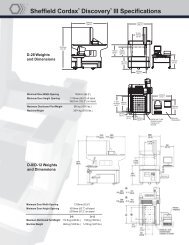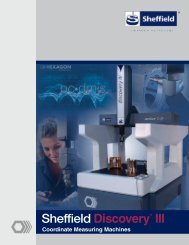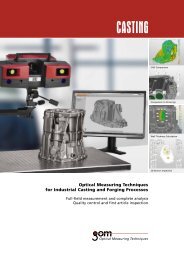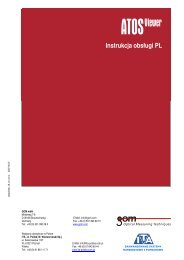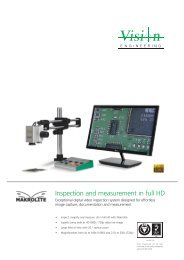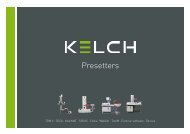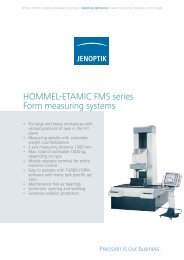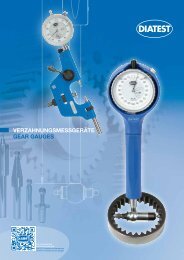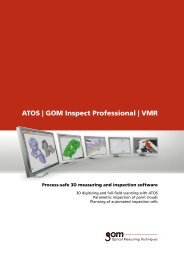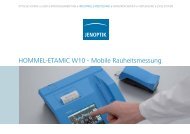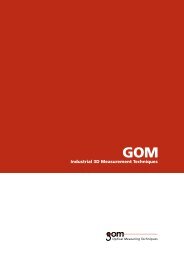Industrial High-End 3D Digitizer
Industrial High-End 3D Digitizer - ITA
Industrial High-End 3D Digitizer - ITA
- No tags were found...
You also want an ePaper? Increase the reach of your titles
YUMPU automatically turns print PDFs into web optimized ePapers that Google loves.
Three-step workflow<br />
Measuring with ATOS is a basic three-step workflow:<br />
• Sensor positioning and measurement: The sensor head is freely positioned<br />
in front of the component. After each measurement, the sensor or part is<br />
moved to obtain areas not captured in the initial scan process. All individual<br />
measurements are automatically transformed into a common coordinate<br />
system immediately providing the complete <strong>3D</strong> point cloud.<br />
• Evaluation: The polygon mesh and features such as edges, holes, etc. are<br />
mathematically transformed into the coordinate system of the component<br />
using RPS, 3-2-1 or Best-Fit registration. The measured and aligned data is<br />
used for STL export, CAD comparison, verification of shape and position<br />
tolerances, verification of specifications from drawings or files.<br />
• Reports and results: The results of the detailed analysis, such as dimensions,<br />
sections, primitives and nominal / actual comparison are exported in reports<br />
or a number of different data formats.<br />
<strong>Industrial</strong> advantages for industrial processes<br />
More than 10 years ago, the automotive industry was the driving force for the<br />
development of the ATOS full-field digitizing systems. These systems were<br />
utilized to capture form information from cars and components for the reverse<br />
engineering process to generate CAD models.<br />
Today, the ATOS is used for many industrial measuring applications. Inspection,<br />
root cause analysis and quality assurance of sheet metal stampings, machined<br />
and formed parts, composite lay-ups, assemblies, interiors and entire vehicles<br />
and aircraft are typical applications in the automotive, aerospace and consumer<br />
sectors. Other high return on investment areas are prototyping, mold making,<br />
tool making, injection molding, die-casting, precision casting, and blow molding<br />
applications.<br />
These industrial processes are improved by:<br />
• Complete product control<br />
• Improved quality<br />
• Reduced manufacturing time<br />
• Earlier identification of tendencies<br />
• <strong>High</strong>er quantities by product introduction<br />
• Faster from idea to finished product<br />
The industry thus benefits from the ATOS solution by:<br />
• Reduction of product development times<br />
• Enhancement of the process security<br />
• Optimization of production procedures
Complete workflow in one software application<br />
GOM completely develops the ATOS hardware and software in house. The software is used to run the<br />
sensor head, to process the <strong>3D</strong> point cloud and to edit and post-process the data.<br />
Through a simple graphical user interface, the ATOS software supports today's tasks in quality control,<br />
manufacturing processes and reverse engineering.<br />
Sensor control, polygon mesh generation and editing, sectioning, feature line detection, primitive<br />
generation are basic software functions. For quality control and result analysis, tools such as CAD data<br />
import; import of measuring plans; registration; full-field deviation plots; section-based analysis; deviation<br />
of individual points; calipers, angles and diameters; report creation are available.<br />
These built-in features enable ATOS to:<br />
• Integrate in automation processes<br />
• Communicate with analysis tools<br />
• Batch process multiple projects<br />
Free result viewer<br />
Full-field measuring data allows for an easy understanding of problematic areas and a faster finding of<br />
possible solutions. To support the interaction between measurement, analysis, construction and development<br />
department, all data created in ATOS can be bundled in one session file. A free result viewer is available<br />
to review the measurement results and to perform simple analysis operations such as editing the<br />
representations, creating additional analysis elements and exporting the results in reports.
<strong>Industrial</strong> environments and notebook operated sensor<br />
Instead of moving the measurement component to the measuring machine, the ATOS sensor comes to<br />
the object. To easily handle and transport the sensor in metrology and analysis rooms as well as production<br />
and factory facilities, the controller device is integrated into the sensor head and light-weight and robust<br />
cables are used.<br />
The computer case provides an adjustable work surface which can be set to either sitting or stand working<br />
height.<br />
As an alternative to a high powered rack mount PC, the ATOS can be operated directly using a notebook<br />
PC. The notebook-based solution combined with a light-weight stand and the transporting suitcase that<br />
also holds all other accessories allows easy traveling.<br />
To combine computer power and transportability, both PC solutions can be used with the same sensor<br />
without the need of any changes.<br />
ATOS HR<br />
ATOS II / II SO<br />
ATOS I / I SO<br />
ATOS Std<br />
ATOS HR SO<br />
ATOS IIe / III<br />
ATOS II / II SO<br />
ATOS IIe / III
ATOS<br />
Sensor Variations<br />
The ATOS <strong>3D</strong> <strong>Digitizer</strong>s are available in different<br />
variations to meet application requirements<br />
perfectly. Each sensor type is combined with the<br />
full ATOS software providing the quality polygon<br />
mesh and extensive post-processing functionalities.<br />
ATOS II<br />
The ATOS II with its compact light sensor head<br />
and fast measurement procedure has been<br />
developed for the highest degree of flexibility.<br />
The available measuring areas span over a large<br />
range and can even be extended by switching to<br />
the "SO" configuration.<br />
The ATOS II captures the data from the two 1.4<br />
million pixel cameras within 1 second.<br />
ATOS IIe<br />
The ATOS IIe provides an extremely bright light<br />
source (4500 ANSI-Lumen) which enables<br />
measurements in difficult ambient conditions. Two<br />
1.4 million pixel cameras deliver <strong>3D</strong> coordinates<br />
even on dark surfaces in rough environments.<br />
The integrated controller reduces the overall<br />
number of components and provides a streamlined<br />
measuring device.<br />
ATOS III<br />
The ATOS III combines the high performance light<br />
source with two 4 million pixel cameras. It allows<br />
measuring smallest details with highest resolution<br />
and realizing largest measuring areas of up to<br />
2m x 2m.<br />
Using 4 million <strong>3D</strong> coordinates in a single<br />
measurement provides a time efficient data<br />
capture as larger measuring areas with high<br />
resolution can be used.<br />
Automation using robots and<br />
kinematics<br />
Increasing demands for a higher throughput and<br />
reduced cycle time for process optimization require<br />
the automation of measurement and evaluation.<br />
For an efficient automation, GOM develops, supplies<br />
and supports:<br />
• Measuring hardware<br />
• Sensor and robot control<br />
• Scanning software<br />
• Data handling and editing<br />
• Import of nominal data and measuring plans<br />
• CAD comparison<br />
• Inspection reporting<br />
For repeated measurements, automation devices<br />
like robots, rotation tables or linear units are used<br />
to handle the sensor head or measurement object.<br />
A macro is recorded within the ATOS software<br />
containing the device's positions, sensor controls<br />
and all processing steps. Additional measurements<br />
of the same part geometry are repeated<br />
automatically by invoking the measurement macro<br />
with the play button.<br />
ATOS macros are based on a scripting language. The<br />
standard use is a record and play procedure. For<br />
advanced applications, an editing level is available<br />
to perform e.g. conditional loops, sub-macro calls<br />
and operating system actions.
Technical Data<br />
System Configurations ATOS II ATOS IIe ATOS III<br />
Measured Points 1 400 000 in 1s 1 400 000 in 1s 4 000 000 in 2s<br />
Measurement Time 1 second 1 second 2 seconds<br />
Measuring Area (min.) 175 x 140 mm² 175 x 140 mm² 150 x 150 mm²<br />
Measuring Area (max.) 2000 x 1600 mm² 2000 x 1600 mm² 2000 x 2000 mm²<br />
Point Spacing 0.12 - 1.4 mm 0.12 - 1.4 mm 0.07 - 1.0 mm<br />
Stand-Off 730 - 2000 mm 730 - 2000 mm 760 - 2800 mm<br />
Brightness 400 ANSI-Lumen 4500 ANSI-Lumen 4500 ANSI-Lumen<br />
Camera Pixels 2 x 1 400 000 2 x 1 400 000 2 x 4 000 000<br />
Sensor Dimensions 490 x 260 x 170 mm³ 490 x 300 x 170 mm³ 490 x 300 x 170 mm³<br />
Sensor Weight 5.2 kg 7.0 kg 7.4 kg<br />
Positioning Pointers • • •<br />
<strong>High</strong>-<strong>End</strong> PC • • •<br />
Notebook • • •<br />
Sensor Controller external integrated integrated<br />
Automation • • •<br />
Variable Workstation • • •<br />
Cable Length<br />
up to 30m<br />
Transport Case 550 x 800 x 300 mm³, 32kg<br />
Operating Temperature 0° - 40°C<br />
Humidity<br />
non-condensing<br />
Power Supply<br />
90 - 230V AC



